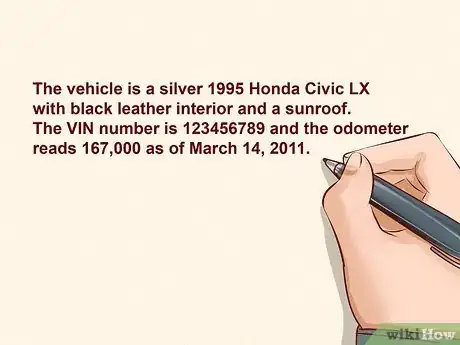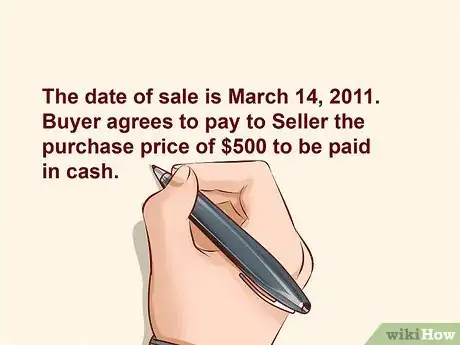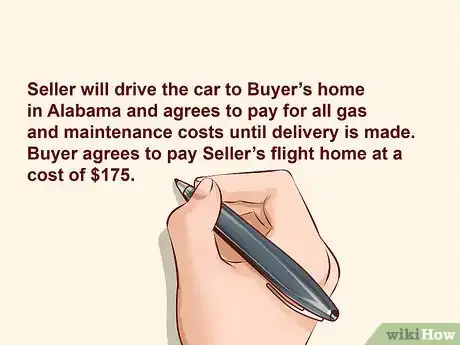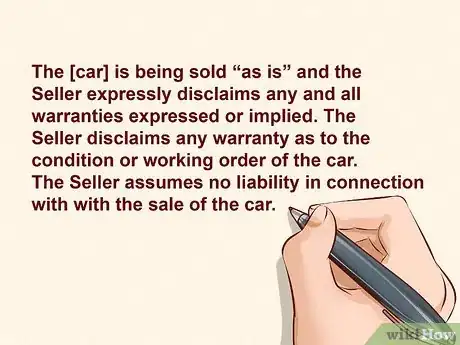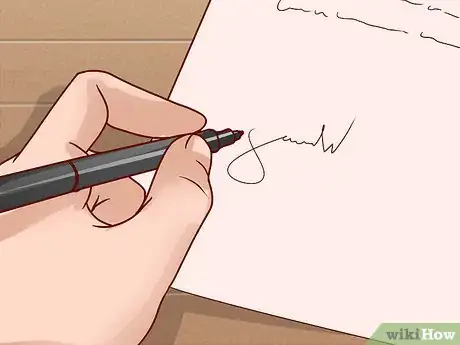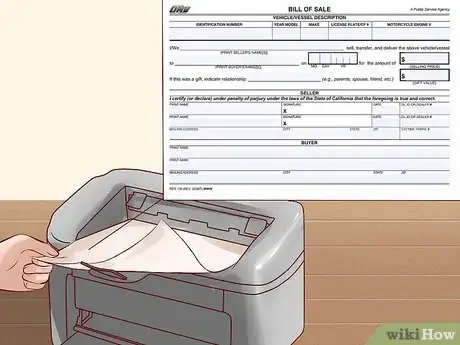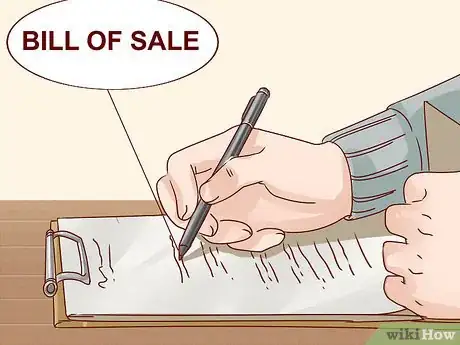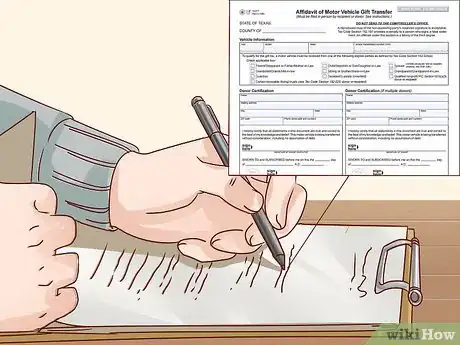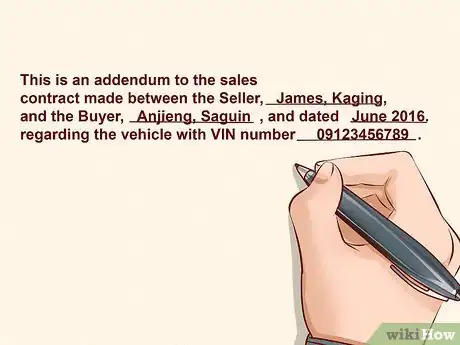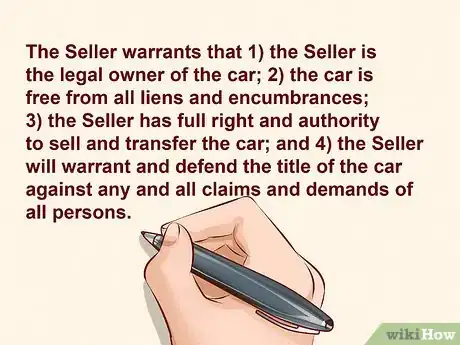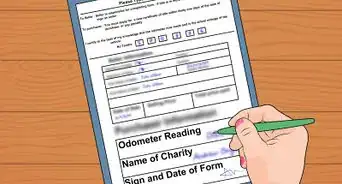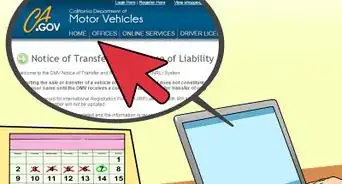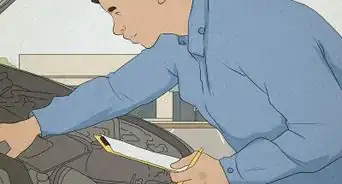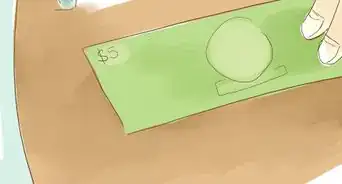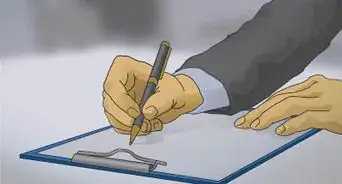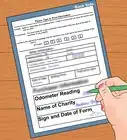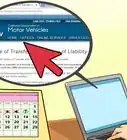This article was co-authored by Bryan Hamby. Bryan Hamby is the owner of Auto Broker Club, a trusted auto brokerage in Los Angeles, California. He founded Auto Broker Club in 2014 out of a passion for cars and a unique talent for customizing the car dealership process to be on the buyer’s side. With 1,400+ deals closed, and a 90% customer retention rate, Bryan’s focus is to simplify the car buying experience through transparency, fair pricing, and world class customer service.
There are 13 references cited in this article, which can be found at the bottom of the page.
This article has been viewed 1,519,509 times.
In some cases, selling a used car to a private buyer is more economical than trading in the car to a car dealership. However, with the increased dollar amount comes the added responsibility of drafting your own sales contract. Fortunately, an auto sales contract, also known as a “Bill of Sale,” is a relatively simple document to create on your own, and many states offer the option of printing a Bill of Sale template from the state's Department of Motor Vehicles (DMV) website.
Steps
Sample Contracts
Writing Your Own Contract
-
1Identify the buyer, seller, and the reason for the contract. The first sentence of the contract should identify the full legal names of both the buyer and the seller and state that the contract is for the sale of a car. For example, “This is a contract made between the Seller, Joe Smith, and the buyer, Dan Jones, for the sale of Joe Smith’s 1995 Honda Civic sedan.”
- Provide the buyer’s and seller’s addresses as well.
- You may also want to provide the driver license numbers of both the buyer and the seller for identification and verification purposes.
EXPERT TIP"The specific requirements for a bill-of-sale contract vary based on your location, so check with the DMV to find out what you need."
Bryan Hamby is the owner of Auto Broker Club, a trusted auto brokerage in Los Angeles, California. He founded Auto Broker Club in 2014 out of a passion for cars and a unique talent for customizing the car dealership process to be on the buyer’s side. With 1,400+ deals closed, and a 90% customer retention rate, Bryan’s focus is to simplify the car buying experience through transparency, fair pricing, and world class customer service.
Bryan Hamby
Professional Auto Broker Bryan Hamby
Bryan Hamby
Professional Auto Broker -
2Provide a description of the vehicle. Use as many identifying characteristics of the car as possible.[1] Be specific; if the contract only identifies the model and year of the car as “1990 Toyota Camry” and the owner has two 1990 Toyota Camrys, it would be unclear which car the contract means. Include as many of the following details as possible:
- Color
- Year
- Make and model
- Body type (pickup, SUV, 4 door sedan)
- Interior color
- Any other unique features of the car (including cosmetic or mechanical problems)
- Vehicle Identification Number (VIN)
- Odometer reading
- For example, “The vehicle is a silver 1995 Honda Civic LX with black leather interior and a sunroof. The VIN number is 123456789 and the odometer reads 167,000 as of March 14, 2011.”
Advertisement -
3Be sure that the information is accurate. Fraudulent claims about the details of the car or the terms of the sale can lead a contract to be voidable. Be sure that all parties understand each other and that no one is misrepresenting the vehicle or the funds that will be exchanged for the vehicle.[2]
- For example, if the owner of the car notes that the car has 167,000 miles on it in the contract, but knows that the vehicle actually has 200,000 miles and a faulty odometer, the entire contract may be voided.
- If the odometer has ever been replaced or repaired, state this in the contract. You can use the following boilerplate language: “I certify that the car’s odometer was altered for repair or replacement purposes while in my possession, and that the mileage registered on the repaired or replaced odometer was identical to that before service.”[3]
-
4State the date of the sale and the purchase price. Describe the method of payment for the purchase—cash, personal check, cashier’s check, money order, etc.[4] For example, “The date of sale is March 14, 2011. Buyer agrees to pay to Seller the purchase price of $500 to be paid in cash.”
- Though not recommended, you can also stipulate an agreed to payment plan. For example, the buyer might pay $250/month for sixteen months. Only agree to a payment plan if you know the person to whom you are selling the car. A common fraud scheme is for someone to give an initial payment, then take the vehicle and disappear.
- If you do agree to a payment plan, be sure that you hold the car’s title until the payments have all been made in full. After all payments are complete, you can send the title to the new owner via certified mail.
- State whether the purchase price is inclusive of sales taxes. In some states, you must charge sales tax. You can state in the contract that your purchase price includes this sales tax (“inclusive of all sales taxes”), or decide that sales tax is additional to the price (“exclusive of all sales taxes”).
-
5Indicate the delivery method. If the car sale is not local, the delivery method and responsibility should be included in the contract. Options include: shipping the vehicle,[5] delivery by the seller, pick-up by the buyer, or delivery by a third party. If expenses will be incurred during delivery (such as with shipping the vehicle or return flight or rental car for an owner delivery), the contract should indicate who is responsible for paying the delivery expenses.
- Make everything clear. For example, if you live in Georgia and will drive the sold car to the buyer’s home in Alabama and then fly home, state who will be responsible for the gas to drive the car to Alabama and for your flight home: “Seller will drive the car to Buyer’s home in Alabama and agrees to pay for all gas and maintenance costs until delivery is made. Buyer agrees to pay Seller’s flight home at a cost of $175.”
-
6Describe the condition of the vehicle. Sellers usually sell cars “as is,” which limits the seller’s liability for any problems with the car’s condition. A statement that the car is sold “as is” and that the owner “makes no warranties about the condition of the car” is sufficient.[6] [7]
- Boilerplate language regarding the condition of the vehicle can read as follows: “The [car] is being sold “as is” and the Seller expressly disclaims any and all warranties expressed or implied. The Seller disclaims any warranty as to the condition or working order of the car. The Seller assumes no liability in connection with the sale of the car.”[8]
-
7Explain what document the Seller will provide to the Buyer. State that the Seller will provide the Buyer with the vehicle’s title and any other required documents, such as a recent emissions test report or service records. Contact your state’s DMV regarding any other documentation that a seller must provide a buyer.
-
8Specify the status of the title. An owner may only sell a vehicle if it has a clear title, which means that there are no liens on the title for car loans or other legal action against the owner. In some cases, a seller can sell a car when the bank still holds the title (i.e., the seller still owes money on the car).
- You can include “boilerplate” language to indicate the status of the title if you own the car, such as the following: “The Seller warrants that 1) the Seller is the legal owner of the car; 2) the car is free from all liens and encumbrances; 3) the Seller has full right and authority to sell and transfer the car; and 4) the Seller will warrant and defend the title of the car against any and all claims and demands of all persons.”[9]
- Get a payoff letter from the financing company if you are still making payments on the car. This will provide exactly the amount of money that you still owe on the car, and which your buyer must pay to purchase the car.[10]
- In most cases where a bank holds the vehicle title, the buyer writes one check directly to the bank for the payoff amount and another check to the seller for the remaining amount between the payoff and the sales price. In this case, the bank can usually mail the title to the buyer upon receiving the correct payoff amount.
-
9Sign and date the contract. Each party should sign and date the contract. Make a copy of the contract after everyone signs. One party should retain the original and one party should retain a copy. It does not matter who retains the copy versus the original. [11]
- A witness should also sign the contract after each party has signed the contract. Though it may not be legally required to have a witness to the sale of a car in most states,[12] having a witness to the contract may mitigate legal disputes about the accuracy of the contract.
- You can also sign the contract in front of a notary, if you wish. This adds another layer of protection, as the notary provides solid evidence that both of you are who you claimed and that you both agreed to the terms of the contract.
Using a Bill of Sale Template
-
1Print out a Bill of Sale. Many states have readymade Bill of Sale forms. These are relatively simple documents for sales that do not require special agreements or circumstances. To find such a form, visit your state’s DMV or Department of Transportation website. Then search for a Bill of Sale. Print out the document.
- For example, you can find the Arizona Department of Transportation’s Bill of Sale here
EXPERT TIP"The DMV has a bill-of-sale template that you can use as a contract. Just download, print, and complete the form."
Bryan Hamby is the owner of Auto Broker Club, a trusted auto brokerage in Los Angeles, California. He founded Auto Broker Club in 2014 out of a passion for cars and a unique talent for customizing the car dealership process to be on the buyer’s side. With 1,400+ deals closed, and a 90% customer retention rate, Bryan’s focus is to simplify the car buying experience through transparency, fair pricing, and world class customer service.
Bryan Hamby
Professional Auto Broker Bryan Hamby
Bryan Hamby
Professional Auto Broker -
2Fill out the Bill of Sale. The Bill of Sale will likely be split into a buyer’s section and a seller’s section. You will have to fill out the party and vehicle information on each section, so each party can keep a copy for her own records.
- Information you can expect to fill out includes the car’s VIN, make, and model, the name and permanent address of each party involved, and the sales amount. There will also be spaces in which each party involved will sign and date the document.
-
3Indicate if the vehicle is a gift. Bill of Sale forms will also have spaces to indicate whether the vehicle is a gift or donation. Make sure you fill out this portion of the Bill of Sale for tax purposes.
- In some states, you may be able to transfer the title to a family member or relative for free or a low fee. If you want to give the car as a gift, you may need an additional form, such as the Affidavit of Motor Vehicle Gift Transfer in Texas.[13] [14]
- It used to be that you could “sell” a car for $1, thereby allowing the buyer to avoid paying significant sales taxes. Most states have found ways to circumvent this. For example, in Texas, if you are selling a car, the buyer will pay motor vehicle sales tax of 6.25% on either the purchase price or the “standard presumptive value” of the car, whichever is highest. The state of Texas determines the standard presumptive value.[15]
-
4Add an addendum to the Bill of Sale. The parties may want to include additional information missing from the preexisting Bill of Sale.[16] An addendum can include such information as: the vehicle being sold “as is,” requirement for the seller to provide the title or upkeep documents, known defects, smog certification, or additional identifying information for the vehicle like mileage or interior color. You should also include information above the addendum linking it to the Bill of Sale, such as:
- This is an addendum to the sales contract made between the Seller, ___________________, and the Buyer, _________________, and dated ______________, regarding the vehicle with VIN number ______________________.
- Have a witness present, and make sure all parties date the addendum after both printing and signing their names.
-
5Specify the status of the title in the addendum. An owner may only sell a vehicle if it has a clear title, which means that there are no liens on the title for car loans or other legal action against the owner. In some cases, a seller can sell a car when the bank still holds the title (i.e., the seller still owes money on the car).
- You can include “boilerplate” language to indicate the status of the title if you own the car, such as the following: “The Seller warrants that 1) the Seller is the legal owner of the car; 2) the car is free from all liens and encumbrances; 3) the Seller has full right and authority to sell and transfer the car; and 4) the Seller will warrant and defend the title of the car against any and all claims and demands of all persons.”[17]
- Get a payoff letter from the financing company if you are still making payments on the car. This will provide exactly the amount of money that you still owe on the car, and which your buyer must pay to purchase the car.[18]
- In most cases where a bank holds the vehicle title, the buyer writes one check directly to the bank for the payoff amount and another check to the seller for the remaining amount between the payoff and the sales price. In this case, the bank can usually mail the title to the buyer upon receiving the correct payoff amount.
-
6Keep a copy for your records. After both parties have filled out and signed the Bill of Sale, make sure that each person has a copy for their own records. The Bill of Sale will also make it easier when transferring the title of the vehicle.
Community Q&A
-
QuestionIf the seller states the car is in great condition, then the car messes up on me a few days later, can I get a refund or sue?
 Community AnswerYes, you can sue. But you will need proof from a mechanic that the car has been "messed up" since before you purchased it.
Community AnswerYes, you can sue. But you will need proof from a mechanic that the car has been "messed up" since before you purchased it. -
QuestionIf I bought a car with custom rims and the seller removed them, can I ask that they be returned?
 Community AnswerIt depends on if your contract stated that the rims were staying with the car, so read it thoroughly before you request them back.
Community AnswerIt depends on if your contract stated that the rims were staying with the car, so read it thoroughly before you request them back. -
QuestionIf I have the car title in my name, do I have to continue to pay my friend for the car after he asks for more money?
 Community AnswerIf you have not paid the balance and still owe him money on the vehicle, AND you have a contract, yes. If you have paid the full amount and he is requesting more after that, then no.
Community AnswerIf you have not paid the balance and still owe him money on the vehicle, AND you have a contract, yes. If you have paid the full amount and he is requesting more after that, then no.
References
- ↑ http://www.carsdirect.com/used-car-buying/how-to-properly-write-a-bill-of-sale-to-make-it-legal
- ↑ http://www.legalmatch.com/law-library/article/void-vs-voidable-contract-lawyers.html
- ↑ http://www.lawdepot.com/contracts/bill-of-sale/preview.aspx?loc=US&
- ↑ http://money.howstuffworks.com/how-to-write-bill-of-sale.htm
- ↑ http://www.edmunds.com/car-buying/how-to-ship-a-car-you-bought-online.html
- ↑ http://www.carfax.com/blog/buying-used-cars-as-is/
- ↑ http://www.carsdirect.com/used-car-buying/how-to-properly-write-a-bill-of-sale-to-make-it-legal
- ↑ http://www.lawdepot.com/contracts/bill-of-sale/preview.aspx?loc=US&
- ↑ http://www.lawdepot.com/contracts/bill-of-sale/preview.aspx?loc=US&
- ↑ https://www.carsdirect.com/sell-cars/how-to-sell-a-car-while-youre-still-making-payments-on-it
- ↑ http://www.legalmatch.com/law-library/article/writing-and-signature-requirements-for-a-valid-contract.html
- ↑ http://www.legalmatch.com/law-library/article/writing-and-signature-requirements-for-a-valid-contract.html
- ↑ http://comptroller.texas.gov/taxinfo/taxforms/14-317.pdf
- ↑ http://www.dmv.org/articles/gifting-cars-and-paying-taxes/
- ↑ http://www.txdmv.gov/motorists/buying-or-selling-a-vehicle
- ↑ http://www.nolo.com/legal-encyclopedia/amending-existing-contract-33348.html
- ↑ http://www.lawdepot.com/contracts/bill-of-sale/preview.aspx?loc=US&
- ↑ https://www.carsdirect.com/sell-cars/how-to-sell-a-car-while-youre-still-making-payments-on-it
- ↑ https://www.dmv.ca.gov/portal/dmv/?1dmy&urile=wcm:path:/dmv_content_en/dmv/pubs/brochures/fast_facts/ffvr32
About This Article
Start your car sale contract by identifying the seller, buyer, and reason for the contract, and provide a detailed description of the vehicle, including the make, model, year, color, VIN, and odometer reading. Include the date of sale and agreed upon purchase price. If you don't plan on providing a warranty for the car, describe the condition of the vehicle as "as is." Remember to state what the seller will provide to the buyer, like the title and other required documents. For tips on using a bill of sale template, read on!



